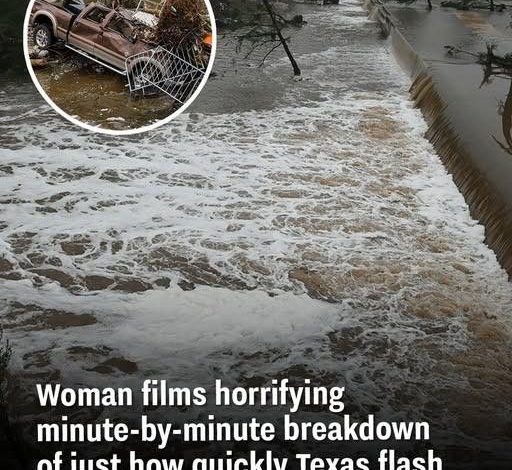What This Family Captured on Camera During Their July 4 Celebration Left the Nation in Shock

A Celebration Turned Catastrophe: Flash Floods Devastate Central Texas, Leaving Dozens Dead and Many Missing
What began as a joyful Fourth of July celebration in Central Texas ended in unimaginable tragedy, as sudden flash floods tore through Kerr County with terrifying speed, claiming dozens of lives and leaving hundreds of families shattered.
The morning of July 4th was filled with laughter, barbecues, and the joyful sounds of children playing along the banks of the Guadalupe and Frio Rivers. Families gathered in the sunshine, snapping photos, waving flags, and savoring a day meant for memory-making. But by late afternoon, the skies darkened—and within 45 minutes, all joy turned to horror.
Floodwaters surged without warning, fed by intense rainfall upstream and made deadly by the steep terrain and narrow waterways. Homes, cars, and campsites were swept away. Locals, still in their holiday attire, scrambled for higher ground as rivers swelled beyond anything they’d seen in generations.
Among the hardest hit was Camp Mystic, a beloved summer retreat housing 750 girls at the time. The camp lost power and communications in the chaos, paralyzing efforts to organize evacuation or call for help. Many of the youngest campers had only arrived days earlier.
At least 51 people are confirmed dead, including 15 children, with over 20 girls—many from Camp Mystic—still missing. The numbers continue to rise as emergency crews comb through the wreckage and use helicopters, boats, and drones to search the murky waters.
The scope of the disaster came into sharp focus through a TikTok video posted by @kelseycrowder_, which has since garnered millions of views. In the footage, a peaceful riverbank is shown gradually overtaken by a rising, violent current. The transformation from calm to catastrophic takes just over an hour—a harrowing real-time record of nature’s wrath.
The video has also become a focal point of national outrage. Many viewers have asked the same question: Where were the warnings?
Texas officials have insisted they’re doing everything possible in the aftermath, deploying search-and-rescue teams, opening emergency shelters, and issuing disaster declarations. Governor Greg Abbott has expanded the state of emergency to cover surrounding counties and requested federal assistance.
But the backlash is growing. Critics argue that the lack of timely flash flood alerts contributed to the loss of life. Some are pointing to budget cuts made under President Trump’s administration, which reduced funding for agencies like the National Weather Service (NWS) and NOAA, weakening early warning systems and infrastructure for flood modeling.
Supporters of the administration claim the storm’s intensity and the terrain’s natural vulnerability made it nearly impossible to issue timely alerts. Still, many believe that with better preparation and communication, the outcome might have been different.
As rescue crews continue their grim work, temporary memorials line the streets of Kerrville and nearby towns. Teddy bears, candles, and notes from heartbroken families are left by riverbanks and church steps. Prayer vigils have drawn crowds in the thousands, united in grief.
The Kerr County flash flood is already being called one of the deadliest and most preventable natural disasters in recent Texas history. It’s a stark reminder of nature’s unpredictable power—and of the steep cost of government unpreparedness in an era where climate-driven disasters are becoming more frequent and ferocious.
For families waiting by the phone, for volunteers digging through debris, and for those who survived but lost everything, the Fourth of July will never again be just a day of celebration. It will be a day etched in sorrow.